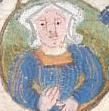Father Edward IV | Name Mary York | |
 | ||
Parents Elizabeth Woodville, Edward IV of England Siblings Elizabeth of York, Cecily of York, Edward V of England Cousins Margaret Pole - Countess, Edward Stafford - 3rd Duke, Edward Plantagenet - 17th Earl, John de la Pole - 1st Earl of Li, Edward of Middleham - Prince of Similar People | ||
Mary of York (11 August 1467 – 23 May 1482) was the second daughter of Edward IV of England and his queen consort Elizabeth Woodville.
Contents
Family
She was a younger sister of Elizabeth of York and an older sister of Cecily of York, Edward V of England, Margaret of York, Richard of Shrewsbury, 1st Duke of York, Anne of York, George Plantagenet, Duke of Bedford, Catherine of York and Bridget of York.
Marriage proposals
Little is known about the second York princess except that she was born in Windsor Castle, and one of her sponsors was Cardinal Bourchier. There were reportedly plans to marry her to John, King of Denmark but nothing came of them; John married Christina of Saxony in 1478.
Lady of the Garter
In 1480, Mary was named a Lady of the Garter along with her younger sister Cecily of York. Their older sister Elizabeth had already been a Lady of the Garter since 1477.
Death and burial
Mary died at Greenwich on 23 May 1482, and was buried in St George's Chapel at Windsor Castle. In 1789, workmen carrying out repairs in St. George's Chapel, Windsor, rediscovered and accidentally broke into the vault of Edward IV and Queen Elizabeth Woodville, discovering in the process what appeared to be a small adjoining vault. This vault was found to contain the coffins of two mysterious, unidentified children. However, no inspection or examination was carried out and the tomb was resealed and inscribed with the names of two of Edward IV's children George, 1st Duke of Bedford, died at the age of 2; and Mary of York died age 14, that had predeceased the King.[16] During the excavation for the royal tomb house for King George III under the Wolsey tomb-house in 1810-1813, two lead coffins clearly labelled as George Plantagenet and Mary Plantagenet were discovered and moved into the adjoining vault belonging to Edward IV, but at the time no effort was made to identify the two lead coffins already in the vault.[17] The coffin of Mary was opened, the beautiful girl of fourteen who had died a year before her father. A shock of her pale gold hair had insinuated itself through the chinks of the coffin; the eyes were pale blue and open, but turned to dust however soon after the admission of air. Some of the hair was cut off by Henry Halford, who in turn passed it to Agnes Strickland.citation needed
In the late 1990s, work was being carried out near and around Edward IV's tomb in St George's Chapel, the floor area was excavated to replace an old boiler and also to add a new repository for the remains of future Deans and Canons of Windsor. A request was forwarded to the Dean and Canons of Windsor to consider a possible examination of the two vaults either by fibre-optic camera or, if possible, a reexamination of the two unidentified lead coffins in the tomb also housing the lead coffins of two of Edward IV's children that were discovered during the building of the Royal Tomb for King George III (1810–1813), and placed in the adjoining vault at that time. With modern scientific testing methods it might be possible to determine who else is buried next to Edward IV's tomb. Royal consent would be necessary to open any royal tomb, so it was felt best to leave the medieval mystery unsolved for at least the next few generations.[18]
